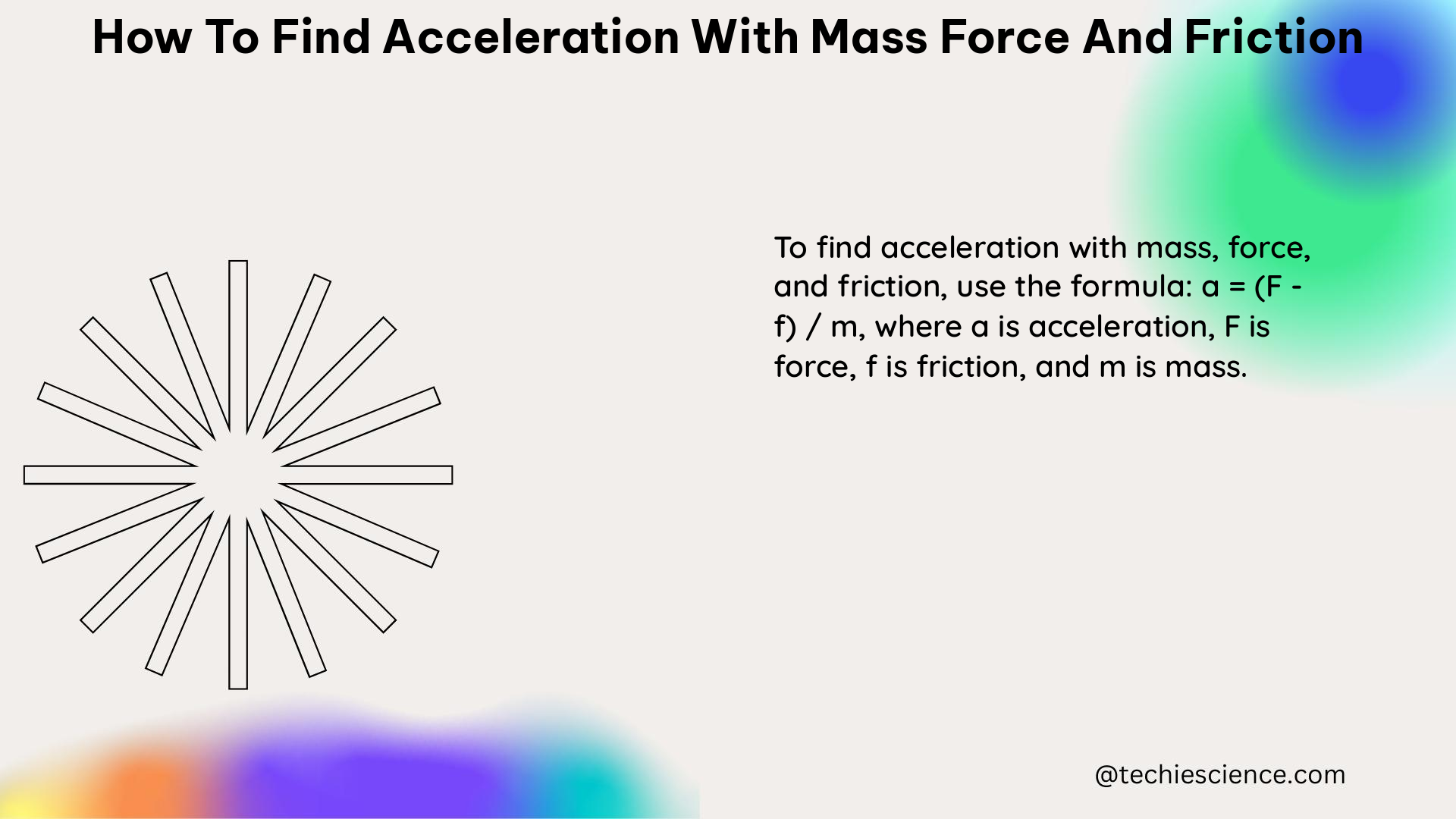When it comes to understanding the motion of objects, the concept of acceleration is crucial. Acceleration is the rate of change in an object’s velocity, and it is directly influenced by the forces acting upon the object, including mass and friction. In this comprehensive guide, we will delve into the intricacies of finding acceleration using the fundamental principles of physics.
Understanding the Equation for Acceleration
The formula for finding acceleration, based on Newton’s second law, is:
a = (F - f) / m
Where:
– a is the acceleration of the object
– F is the net force acting on the object
– f is the force of friction
– m is the mass of the object
This equation allows us to calculate the acceleration of an object by considering the net force and the force of friction, in relation to the object’s mass.
Calculating the Force of Friction

The force of friction, f, can be calculated using the following formula:
f = μ * FN
Where:
– μ is the coefficient of friction between the object and the surface
– FN is the normal force, which is equal to the weight of the object (mg)
To find the normal force, we use the formula:
FN = mg
Where:
– m is the mass of the object
– g is the acceleration due to gravity (9.8 m/s²)
By calculating the normal force and the coefficient of friction, we can determine the force of friction acting on the object.
Example Calculation
Let’s consider an example to illustrate the process of finding acceleration with mass, force, and friction.
Suppose we have an object with a mass of 5 kg, and an applied force of 20 N. The coefficient of friction between the object and the surface is 0.2.
Step 1: Calculate the normal force (FN)
FN = mg
FN = 5 kg × 9.8 m/s² = 49 N
Step 2: Calculate the force of friction (f)
f = μ × FN
f = 0.2 × 49 N = 9.8 N
Step 3: Calculate the net force (F)
F = Applied force - Force of friction
F = 20 N - 9.8 N = 10.2 N
Step 4: Calculate the acceleration (a)
a = (F - f) / m
a = (10.2 N - 9.8 N) / 5 kg = 0.08 m/s²
Therefore, the acceleration of the object is 0.08 m/s².
Factors Affecting Acceleration
Several factors can influence the acceleration of an object, including:
-
Mass: The mass of the object directly affects the acceleration. Heavier objects require more force to achieve the same acceleration as lighter objects.
-
Net Force: The net force acting on the object, which is the difference between the applied force and the force of friction, determines the acceleration.
-
Coefficient of Friction: The coefficient of friction between the object and the surface affects the force of friction, which in turn influences the acceleration.
-
Inclined Planes: When an object is placed on an inclined plane, the acceleration is affected by the angle of the plane and the force of friction.
-
Air Resistance: In some cases, air resistance can also contribute to the force of friction, affecting the overall acceleration.
Advanced Concepts and Considerations
-
Kinetic and Static Friction: The type of friction (kinetic or static) can impact the force of friction and, consequently, the acceleration.
-
Centripetal Acceleration: When an object is moving in a circular path, the acceleration has both tangential and centripetal components.
-
Rotational Motion: For objects undergoing rotational motion, the acceleration can be calculated using the angular acceleration and the object’s radius.
-
Projectile Motion: In the case of projectile motion, the acceleration due to gravity plays a crucial role in determining the object’s trajectory and acceleration.
-
Numerical Problems and Simulations: Solving numerical problems and using simulations can help reinforce the understanding of acceleration calculations and the factors that influence them.
Conclusion
Mastering the concept of acceleration is essential for understanding the motion of objects in physics. By applying the formulas and principles discussed in this comprehensive guide, you can confidently calculate the acceleration of an object given its mass, the net force, and the force of friction. Remember to consider the various factors that can affect acceleration, and practice solving numerical problems to solidify your understanding of this fundamental topic.
References:
- How to Calculate Acceleration With Friction – Sciencing
https://sciencing.com/calculate-acceleration-friction-6245754.html - How to Calculate the Acceleration of an Object on an Inclined Plane – Study.com
https://study.com/skill/learn/how-to-calculate-the-acceleration-of-an-object-on-an-inclined-plane-explanation.html - Finding Acceleration – The Physics Classroom
https://www.physicsclassroom.com/class/newtlaws/Lesson-3/Finding-Acceleration - Calculating Acceleration from Force and Mass | CK-12 Foundation
https://flexbooks.ck12.org/cbook/ck-12-middle-school-physical-science-flexbook-2.0/section/11.4/primary/lesson/calculating-acceleration-from-force-and-mass-ms-ps/ - Calculating Horizontal Acceleration in Systems with Friction | Physics
https://study.com/skill/learn/calculating-horizontal-acceleration-in-systems-with-friction-explanation.html

The lambdageeks.com Core SME Team is a group of experienced subject matter experts from diverse scientific and technical fields including Physics, Chemistry, Technology,Electronics & Electrical Engineering, Automotive, Mechanical Engineering. Our team collaborates to create high-quality, well-researched articles on a wide range of science and technology topics for the lambdageeks.com website.
All Our Senior SME are having more than 7 Years of experience in the respective fields . They are either Working Industry Professionals or assocaited With different Universities. Refer Our Authors Page to get to know About our Core SMEs.